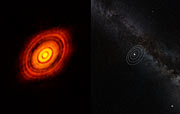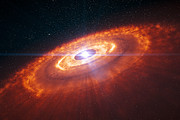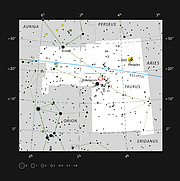Komunikat prasowy
Niesamowity obraz z ALMA ukazuje genezę planet
6 listopada 2014
Zaprezentowane nowe zdjęcie z ALMA, Atacama Large Millimeter/submillimeter Array, pokazuje coś czego nigdy aż tak szczegółowo do tej pory nie oglądano: dokładną strukturę dysku wokół młodej gwiazdy, w którym tworzą się planety. Są to pierwsze obserwacje ALMA wykonane z prawie docelową konfiguracją sieci i najostrzejszy obraz uzyskany na falach submilimetrowych. Nowe wyniki to wielki krok naprzód w obserwacjach rozwoju dysków protoplanetarnych i powstawania planet.
W ramach pierwszych obserwacji ALMA w nowym, potężniejszym trybie, naukowcy skierowali anteny na HL Tauri – młoda gwiazdę odległą o około 450 lat świetlnych, która jest otoczona przez pyłowy dysk [1]. W efekcie uzyskali obraz, który przekroczył wszelkie oczekiwania i bardzo szczegółowo ukazał dysk materii pozostały po narodzinach gwiazdy. Widać na nim serię koncentrycznych, jasnych pierścieni, oddzielonych od siebie przerwami [2].
„Struktury te są prawie na pewno wynikiem formowania się w dysku ciał typu planetarnego. Jest to zaskakujące, ponieważ w przypadku tak młodych gwiazd nie spodziewano się istnienia aż tak dużych ciał planetarnych zdolnych wytworzyć obserwowane na zdjęciu struktury” powiedział Stuartt Order, Wicedyrektor ALMA.
"Gdy zobaczyliśmy zdjęcie po raz pierwszy, byliśmy zdumieni niesamowitym poziomem detali. HL Tauri ma nie więcej niż milion lat, ale dysk już wykazuje cechy pełnych procesów powstawania planet. To zdjęcie zrewolucjonizuje teorie na temat powstawania planet” wyjaśnia Catherine Vlahakis, ALMA Deputy Program Scientist oraz Lead Program Scientist z programu ALMA Long Baseline Campaign.
Dysk HL Tauri wydaje się znacznie bardziej rozwinięty niż można się było spodziewać na podstawie wieku systemu. W związku z tym obraz z ALMA sugeruje także, iż procesy powstawania planet mogą zachodzić szybciej niż do tej pory przypuszczano.
Tak wysoka rozdzielczość może zostać osiągnięta jedynie dzięki wielkobazowym możliwościom ALMA. Astronomowie uzyskują nowe informacje, których nie zebraliby za pomocą innych urządzeń, nawet przy użyciu Kosmicznego Teleskopu Hubble’a. „Logistyka i infrastruktura potrzebna do umieszczenia anten w tak odległym miejscu wymagała niespotykanej koordynacji ze strony ekspertów międzynarodowego zespołu inżynierów i naukowców” powiedział Dyrektor ALMA, Pierre Cox. „Długie bazy stanowią jeden z głównych celów ALMA i są imponującym osiągnięciem technologicznym, naukowym i inżynieryjnym.”
Młode gwiazdy, takie jak HL Tauri, rodzą się w obłokach gazu i pyłu, w obszarach, które zapadły się pod wpływem grawitacji, tworząc gęste, gorące jądra, które w końcu „zapaliły się” stając się nowymi gwiazdami. Młode gwiazdy są początkowo schowane w kokonach pozostałego gazu i pyłu, który skupia się w dysku określanym jako dysk protoplanetarny.
Poprzez liczne zderzenia cząstki pyłu zlepiają się ze sobą, rosnąć w zgrupowania o rozmiarach ziaren piasku i kamyków. W końcu w dysku powstają planetoidy, komety, a nawet planety. Młode planety zaburzają dysk i tworzą pierścienie, przerwy oraz dziury, takie jak struktury obserwowane przez ALMA [3].
Badanie dysków protoplanetarnych jest kluczowe dla zrozumienia w jaki sposób powstała Ziemia w Układzie Słonecznym. Obserwując pierwsze stadia formowania planet wokół HL Tauri można sprawdzić jak mógł wyglądać nasz system planetarny w okresie ponad czterech miliardów lat temu, gdy powstawał.
„Większość tego, co obecnie wiemy o powstawaniu planet bazuje na teorii. Zdjęcia o takim poziomie detali zostaną teraz użyte w symulacjach komputerowych, a także w wizualizacjach przedstawiających te etapy powstawania planet. Obraz HL Tauri pokazuje co ALMA może osiągnąć pracując w swojej największej konfiguracji i rozpoczyna nową erę w eksploracji tematu powstawania gwiazd i planet” mówi Tim de Zeeuw, Dyrektor Generalny ESO.
Uwagi
[1] Od września 2014 r. ALMA obserwuje Wszechświat korzystając z najdłuższych jak dotąd baz, z antenami oddalonymi od siebie na odległość do 15 km. Kampania o nazwie Long Baseline Campaign będzie trwać do 1 grudnia 2014 r. Długość bazy to odległość pomiędzy dwoma antenami w sieci. Dla porównania, inne urządzenia pracujące w zakresie fal submilimetrowych mają anteny odseparowane o nie więcej niż dwa kilometry. Maksymalna możliwa baza dla ALMA to 16 kilometrów. Przyszłe obserwacje na krótszych falach uzyskają jeszcze lepszą ostrość obrazów.
[2] Struktury są widoczne z rozdzielczością zaledwie pięciokrotnie większą niż dystans Ziemi od Słońca. Odpowiada to kątowej rozdzielczości około 35 milisekund łuku – lepszej niż uzyskiwana w typowych obserwacjach za pomocą Kosmicznego Teleskopu Hubble’a.
[3] W zakresie światła widzialnego HL Tauri jest ukryta w masywnej otoczce gazu i pyłu. ALMA obserwuje na falach znacznie dłuższych, co pozwala na badanie procesów we wnętrzu takiego obłoku.
Więcej informacji
Międzynarodowy kompleks astronomiczny ALMA działa w ramach partnerstwa pomiędzy Europą, Ameryką Północną i Azją Wschodnią, we współpracy z Chile. ALMA jest finansowana w Europie przez Europejskie Obserwatorium Południowe (ESO), w Ameryce Północnej przez U.S. National Science Foundation (NSF), we współpracy z National Research Council of Canada (NRC) oraz National Science Council of Tajwan (NSC), a w Azji Wschodniej przez National Institutes of Natural Sciences (NINS) of Japan, we współpracy z Academia Sinica (AS) in Taiwan. Konstrukcja i użytkowanie ALMA w imieniu Europy jest kierowane przez ESO, w imieniu Ameryki Północnej przez National Radio Astronomy Observatory (NRAO), zarządzane przez Associated Universities, Inc. (AUI), a w imieniu Azji Wschodniej przez National Astronomical Observatory of Japan (NAOJ). Joint ALMA Observatory (JAO) umożliwia wspólne kierowanie i zarządzanie konstrukcją, testowaniem i użytkowaniem ALMA.
ESO jest wiodącą międzyrządową organizacją astronomiczną w Europie i najbardziej produktywnym obserwatorium astronomicznym na świecie. Wspiera je 16 krajów: Austria, Belgia, Brazylia, Czechy, Dania, Finlandia, Francja, Hiszpania, Holandia, Niemcy, Polska, Portugalia, Szwajcaria, Szwecja, Wielka Brytania oraz Włochy. ESO prowadzi ambitne programy dotyczące projektowania, konstrukcji i użytkowania silnych naziemnych instrumentów obserwacyjnych, pozwalając astronomom na dokonywanie znaczących odkryć naukowych. ESO odgrywa wiodącą rolę w promowaniu i organizowaniu współpracy w badaniach astronomicznych. ESO zarządza trzema unikalnymi, światowej klasy obserwatoriami w Chile: La Silla, Paranal i Chajnantor. W Paranal ESO posiada teleskop VLT (Very Large Telescope - Bardzo Duży Teleskop), najbardziej zaawansowane na świecie astronomiczne obserwatorium w świetle widzialnym oraz dwa teleskopy do przeglądów. VISTA pracuje w podczerwieni i jest największym na świecie instrumentem do przeglądów nieba, natomiast VLT Survey Telescope to największy teleskop dedykowany przeglądom nieba wyłącznie w zakresie widzialnym. ESO jest europejskim partnerem dla rewolucyjnego teleskopu ALMA, największego istniejącego projektu astronomicznego. ESO planuje obecnie 39-metrowy teleskop E-ELT (European Extremely Large optical/near-infrared Telescope - Ekstremalnie Wielki Teleskop Europejski), który stanie się “największym okiem świata na niebo”.
Linki
- Więcej o ALMA
- Zdjęcia ALMA
- Filmy o ALMA
- Broszura ALMA
- Film: ALMA — In Search of our Cosmic Origins
- Album: In Search of our Cosmic Origins – The Construction of the Atacama Large Millimeter/submillimeter Array
- Więcej komunikatów prasowych na temat wyników z ALMA
- Katalog dysków wokółgwiazdowych
Kontakt
Catherine Vlahakis
Joint ALMA Observatory
Santiago, Chile
Tel.: +56 9 75515736
E-mail: cvlahaki@alma.cl
Valeria Foncea Rubens
Joint ALMA Observatory
Santiago, Chile
Tel.: +56 2 24676258
E-mail: vfoncea@alma.cl
Richard Hook
ESO education and Public Outreach Department
Garching bei München, Germany
Tel.: +49 89 3200 6655
Tel. kom.: +49 151 1537 3591
E-mail: rhook@eso.org
Krzysztof Czart (Kontakt dla mediów Polska)
Sieć Popularyzacji Nauki ESO
oraz Urania - Postępy Astronomii
Toruń, Polska
Tel.: +48 513 733 282
E-mail: eson-poland@eso.org
O komunikacie
| Komunikat nr: | eso1436pl |
| Nazwa: | HL Tauri |
| Typ: | Milky Way : Star : Circumstellar Material : Disk : Protoplanetary |
| Facility: | Atacama Large Millimeter/submillimeter Array |
| Science data: | 2015ApJ...808L...3A |
Our use of Cookies
We use cookies that are essential for accessing our websites and using our services. We also use cookies to analyse, measure and improve our websites’ performance, to enable content sharing via social media and to display media content hosted on third-party platforms.
ESO Cookies Policy
The European Organisation for Astronomical Research in the Southern Hemisphere (ESO) is the pre-eminent intergovernmental science and technology organisation in astronomy. It carries out an ambitious programme focused on the design, construction and operation of powerful ground-based observing facilities for astronomy.
This Cookies Policy is intended to provide clarity by outlining the cookies used on the ESO public websites, their functions, the options you have for controlling them, and the ways you can contact us for additional details.
What are cookies?
Cookies are small pieces of data stored on your device by websites you visit. They serve various purposes, such as remembering login credentials and preferences and enhance your browsing experience.
Categories of cookies we use
Essential cookies (always active): These cookies are strictly necessary for the proper functioning of our website. Without these cookies, the website cannot operate correctly, and certain services, such as logging in or accessing secure areas, may not be available; because they are essential for the website’s operation, they cannot be disabled.
Functional Cookies: These cookies enhance your browsing experience by enabling additional features and personalization, such as remembering your preferences and settings. While not strictly necessary for the website to function, they improve usability and convenience; these cookies are only placed if you provide your consent.
Analytics cookies: These cookies collect information about how visitors interact with our website, such as which pages are visited most often and how users navigate the site. This data helps us improve website performance, optimize content, and enhance the user experience; these cookies are only placed if you provide your consent. We use the following analytics cookies.
Matomo Cookies:
This website uses Matomo (formerly Piwik), an open source software which enables the statistical analysis of website visits. Matomo uses cookies (text files) which are saved on your computer and which allow us to analyze how you use our website. The website user information generated by the cookies will only be saved on the servers of our IT Department. We use this information to analyze www.eso.org visits and to prepare reports on website activities. These data will not be disclosed to third parties.
On behalf of ESO, Matomo will use this information for the purpose of evaluating your use of the website, compiling reports on website activity and providing other services relating to website activity and internet usage.
Matomo cookies settings:
Additional Third-party cookies on ESO websites: some of our pages display content from external providers, e.g. YouTube.
Such third-party services are outside of ESO control and may, at any time, change their terms of service, use of cookies, etc.
YouTube: Some videos on the ESO website are embedded from ESO’s official YouTube channel. We have enabled YouTube’s privacy-enhanced mode, meaning that no cookies are set unless the user actively clicks on the video to play it. Additionally, in this mode, YouTube does not store any personally identifiable cookie data for embedded video playbacks. For more details, please refer to YouTube’s embedding videos information page.
Cookies can also be classified based on the following elements.
Regarding the domain, there are:
- First-party cookies, set by the website you are currently visiting. They are stored by the same domain that you are browsing and are used to enhance your experience on that site;
- Third-party cookies, set by a domain other than the one you are currently visiting.
As for their duration, cookies can be:
- Browser-session cookies, which are deleted when the user closes the browser;
- Stored cookies, which stay on the user's device for a predetermined period of time.
How to manage cookies
Cookie settings: You can modify your cookie choices for the ESO webpages at any time by clicking on the link Cookie settings at the bottom of any page.
In your browser: If you wish to delete cookies or instruct your browser to delete or block cookies by default, please visit the help pages of your browser:
Please be aware that if you delete or decline cookies, certain functionalities of our website may be not be available and your browsing experience may be affected.
You can set most browsers to prevent any cookies being placed on your device, but you may then have to manually adjust some preferences every time you visit a site/page. And some services and functionalities may not work properly at all (e.g. profile logging-in, shop check out).
Updates to the ESO Cookies Policy
The ESO Cookies Policy may be subject to future updates, which will be made available on this page.
Additional information
For any queries related to cookies, please contact: pdprATesoDOTorg.
As ESO public webpages are managed by our Department of Communication, your questions will be dealt with the support of the said Department.












